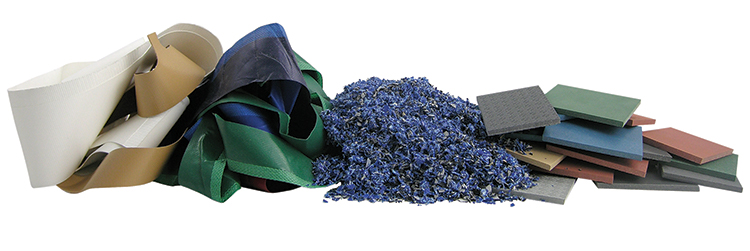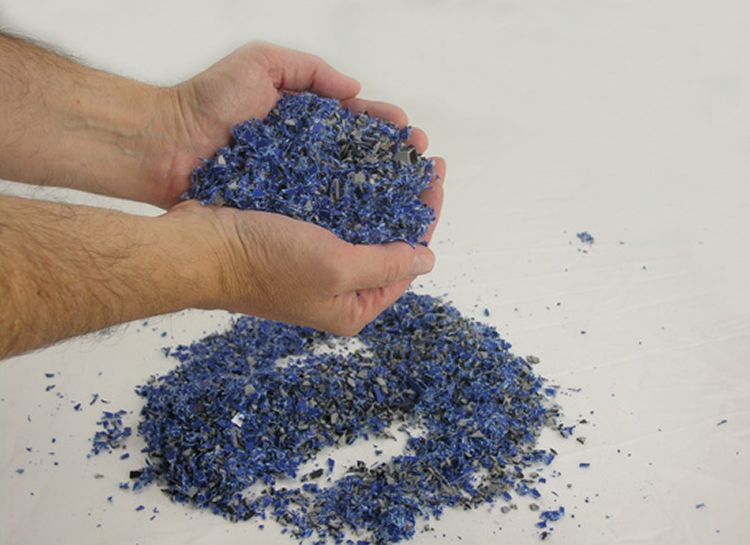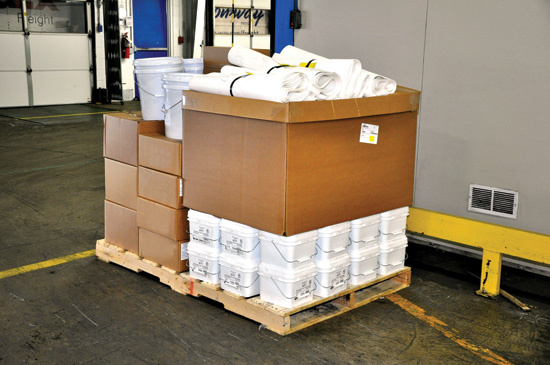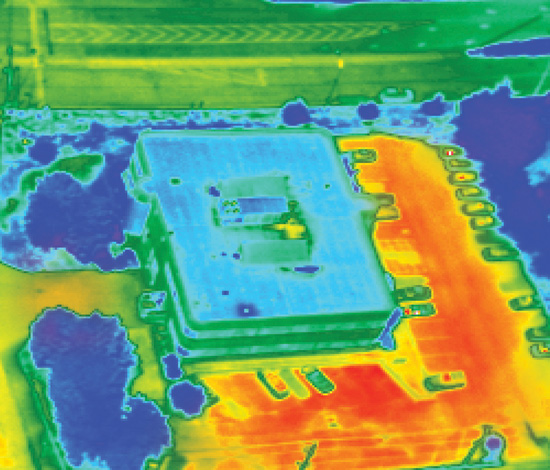This CE Center article is no longer eligible for receiving credits.
Until recently, specifying a sustainable roofing membrane was a tricky business. Lacking a comprehensive, multi-attribute and certifiable assessment of the product, architects and specifiers had to decide which single attribute fit into their sustainability goals: Was it the roofing membrane's durability that mattered most? Or its potential to handle long-term heat exposure? Or its long-term maintenance and repairability? Or its lack of VOCs? Or did the packaging matter most?
Today, all those attributes are contained in one internationally recognized certification: NSF/ANSI 347: Sustainability Assessment for Single-Ply Roofing Membranes.1
The purpose of this article is to explain the significance of the first sustainable certification assessment for single-ply roofing membrane materials, and discuss how a manufacturer earns a certification for a Compliant, Silver, Gold, or Platinum rating. This understanding will give architects and specifiers more options to reach their sustainability goals.
How We Got Here
The evolution of the green building movement in the United States in some ways mirrors the maturing of a human being. We begin our lives quite innocent and unaware (infant), eventually gain some awareness and perhaps wild ambitions (youth and teenage), face realities of life (young adult), and eventually settle in for what is hopefully a long period of productivity (adulthood).
Likewise, unaware could have described the collective U.S. mindset before the Santa Barbara oil spill of 1969 (which spawned the first Earth Day), and the oil embargo of 1973. As abrupt as puberty, a vigorous green building movement arose in the country, with a back-to-the-earth mentality of yurts and berm homes and organic farming.

Photo courtesy of Duro-Last
From its warm and fuzzy, idealistic beginnings, the green building movement has shifted from unproven claims to verifiable single-attribute qualities to robust and far-reaching multi-attribute standards.
In the built environment, some good ideas born in that period persisted, such as tight houses and energy-efficient light bulbs and windows. A plethora of “green” products emerged, but the green claim became notoriously watered down and unreliable. According to The Dictionary of American Slang (Harper Collins Publishers), greenwash is “the practice of promoting environmentally friendly programs to deflect attention from an organization's environmentally unfriendly or less savory activities.”
In the 1990s and 2000s, interest grew in verifiable sustainable building practices, thanks in part to green building rating programs such as the U.S. Green Building Council's LEED®, Leadership in Energy and Environmental Design program, helped along by the American Institute of Architects' vigorous promotion of sustainability. Later, the Green Building Initiative's Green Globes® program and others offered alternatives.
As green building moved into adulthood, highly scientific and rigorous certifications for product sustainability arose, with the initial focus on single attributes such as low VOC, energy saving, or recyclable.
The single-attribute mindset often left specifiers wondering: What is the story of this product during its life cycle, from cradle to gate, cradle to grave, or cradle to cradle?
Life-Cycle Assessment and Multi-Attribute Certifications
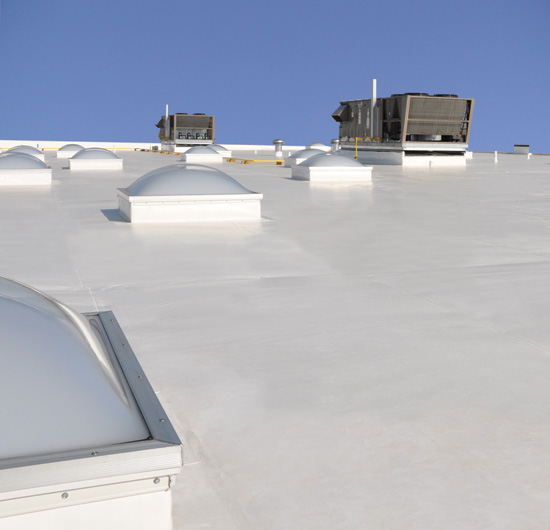
Photo courtesy of Duro-Last
Single-ply membrane roofs are known for their durability and long life. The NSF/ANSI 347 assessment quantifies those qualities and adds more measurable criteria for use in specifying a sustainable roofing material.
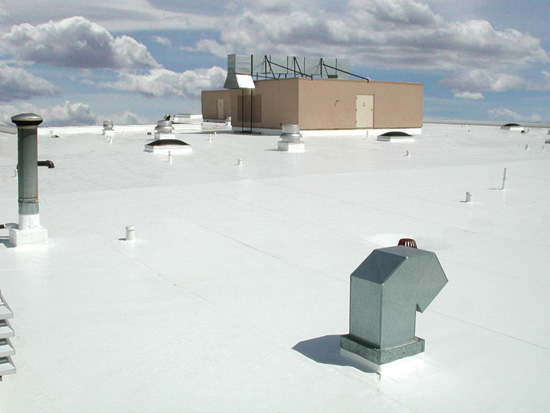
Photo courtesy of Duro-Last
Architects and specifiers can now choose a single-ply roofing membrane based on this wide-reaching sustainability assessment.
And thus emphasis on a product's life-cycle analysis (LCA) emerged, along with Environmental Product Declarations (EPD).
According to Stanley Graveline, who sits on the technical committee of the CFFA, Chemical Fabrics and Film Association – Vinyl Roofing Division, “Today's emphasis on green measurement systems and labels has led to a proliferation of unsubstantiated product marketing claims...The availability of verified EPDs helps architects, roofing consultants, contractors, and owners accurately assess a product's impact on the environment.”
In recent years, interest in creating EPDs has grown. The CFFA – Vinyl Roofing Division announced an EPD for white, single-ply polyester-reinforced PVC roofing membrane. Of course, the U.S. Green Building Council's LEED rating system awards Building Product Disclosure and Optimization credits for projects that include at least 20 building products with published EPDs. Plus, the Green Building Initiative's Green Globes rating system provides a prescriptive path with reference to industry-wide or product-specific EPDs.
Multiple attribute standards are a growing trend among industries like roofing, resilient flooring, commercial furnishings, gypsum board, and flooring tiles.
How the NSF/ANSI 347 Standard Was Created
Within the roofing membrane industry—which includes the manufacturers as well as those who specify and install it—appreciation of the material's favorable and robust LCA is widespread. The goal within the industry was to quantify and document the material's sustainable qualities using established scientific principles and standards. The objective in developing the standard was to have a comprehensive standard that would fully consider all relevant elements of sustainability.
In a multi-year effort, a large number of stakeholders developed the NSF/ANSI 347 standard in a publicly transparent voting process through NSF's international consensus-based and ANSI-accredited standard development process. They included membrane manufacturers, architects, and engineers who specify roofing materials, roofing industry consultants, trade associations, national regulatory agencies that regulate either environmental practices or roofing specifications, and non-governmental organizations.
The products that fall under the scope of this standard include polyvinyl chloride (PVC), thermoplastic polyolefin (TPO), ethylene propylene diene terpolymer (EPDM), ketone ethylene ester (KEE), and polyisobutylene (PIB) products.
The benefits for membrane manufacturers who achieve a rating under this standard are numerous. If a manufacturer claims their product is environmentally preferable and has a superior sustainable “score,” that claim can be backed up by science and data, eliminating incidences of greenwashing. Transparency is the goal.
In the end, the requirements of the standard are intended to form the basis of conformity assessment programs, such as third-party certification or registration.
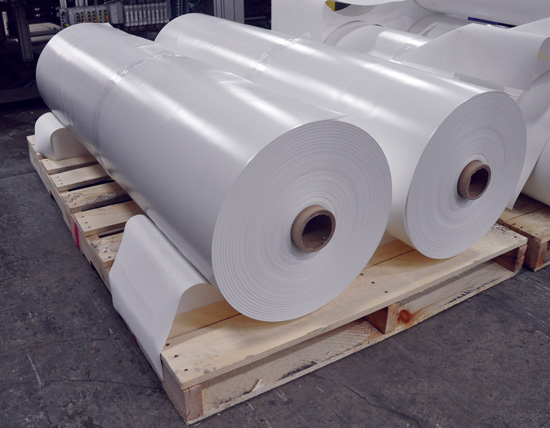
Photo courtesy of Duro-Last
Single-ply roofing membrane is known in the industry to have a very robust life cycle. But it took an NSF/ANSI-created standard to document those facts.
How NSF/ANSI 347 Certification Is Achieved
To achieve a rating according to the NSF/ANSI 347 standard, products are rated in five areas of focus:
| Product Design |
42 points |
| Product Manufacturing |
27 points |
| Membrane Durability |
40 points |
| Corporate Governance |
7 points |
| Innovation |
7 points |
| Total |
123 points |
As you can see, the first three subject areas that comprise the bulk of the points available follow the same trajectory as does a manufactured product from design, to manufacture, to its use in the field. Further points are available for actions on the corporate level, as well as implementation of innovative solutions.
The levels that can be reached are:
| Compliant |
Minimum 35 points |
| Silver |
Minimum 45 points |
| Gold |
Minimum 56 points |
| Platinum |
Minimum 75 Points |
We'll discuss the criteria topics one by one. But first, there are several prerequisites for all single-ply roofing membrane manufacturers who seek a rating. First and foremost, the membrane manufacturer must have a plan for making a sustainably preferable product, and that plan must be implemented early in the process, in the design stage. Product developers and designers should be looking into environmental impacts of their proposed product across its entire life cycle, from raw material extraction to manufacturing, use, and end of life. Both longevity and performance are highly valued in the standard.
Product Design—Where It All Begins
To encourage membrane manufacturers to focus on environmental and life-cycle issues from the beginning, the point system starts at the stage of product design. The standard refers to it as an “enlightened design process.”
Once a manufacturer has achieved the prerequisite of planning, points are available for a wide variety of criteria, from source materials to chemicals used and all the way to reclamation.
Where Did It All Begin? Environmentally Sustainable Source Materials
The purpose of this section is to make sure the membrane manufacturer is informed about the environmental implications of the material composition of its products, and this includes the packaging. This then encourages the use of component materials from sustainable inputs, such as recycled materials and bio-based resources. At the very least, the manufacturer should report materials at certain chemical measurements that would, upon disposal, cause the product to be classified as hazardous waste.
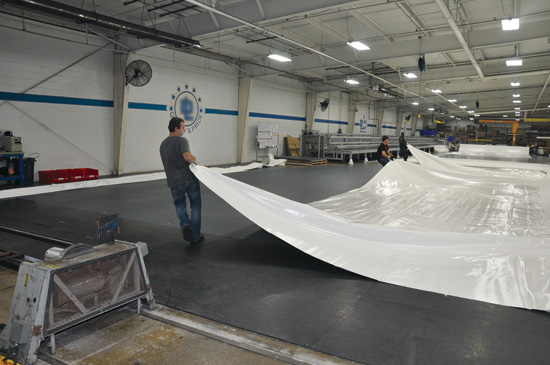
Photo courtesy of Duro-Last
The effort to achieve an NSF/ANSI 347 rating must start from the very beginning of the material’s life cycle.
The standard puts a lot of emphasis on using recycled content, or content from a bio-based source. Most emphasis is put on post-consumer recycled content, which is valued at 100 percent of its weight, with a lesser emphasis on pre-consumer recycled content, valued at 50 percent of its weight. The bio-based content is more valuable, point wise, when it's from such certified operations as organic, sustainable agriculture, or sustainably certified forestry. Other bio-based content is given half the points per weight.
Concern with Chemicals
Not all chemicals are created equal, and not all chemicals are toxins and carcinogens. The “Chemicals of Concern” section of the standard has as its goal to encourage the use of more environmentally friendly chemicals and eliminating the use of chemicals of concern. The latter grouping includes those listed on some of the most widely recognized, science-based hazard lists from the International Agency on the Research of Cancer, the National Toxicology Program, U.S. Occupational Safety and Health Administration, California Proposition 65, and the U.S. Environmental Protection Agency Integrated Risk Information System database. Companies can earn points by avoiding the chemicals on these hazard lists in concentrations greater than 1000 ppm or, 0.1 percent. The manufacturer, to earn one credit, may create a report evaluating its product formulation against the hazard lists. Further eliminating or reducing the concentration of any known hazardous substance can earn up to another 5 points. The purpose of this section is to inform the manufacturer of the human health and ecological hazards associated with the product's raw materials. The credits are weighted heavier on the reduction and elimination credits to encourage the manufacturer to use environmentally compatible products and eliminate the use of chemicals with known hazards.
Causing an Impact Upstream—Informed Selection of Suppliers
Just as a chain is only as strong as its weakest link, the sustainable quality of a roofing membrane manufacturer is dependent on the sustainable qualities of its key suppliers. Does the supplier comply with local, regional and national environmental requirements? Does it have an environmental management system in place? Does it use renewable energy and track greenhouse gas emissions? These factors, if in compliance, earn a point in NSF/ANSI 347.
If a supplier has a social accountability disclosure process—which includes compliance with local, regional and national labor requirements, as well as documentation of social accountability—the membrane manufacturer earns another point. If the percentage of supplier compliance reaches 33 percent of key suppliers, or 50 percent of key suppliers, more points are possible.
At the minimum, these thoughtful point categories cause the membrane manufacturer to examine its own choice of suppliers, and perhaps to make choices based on these criteria.
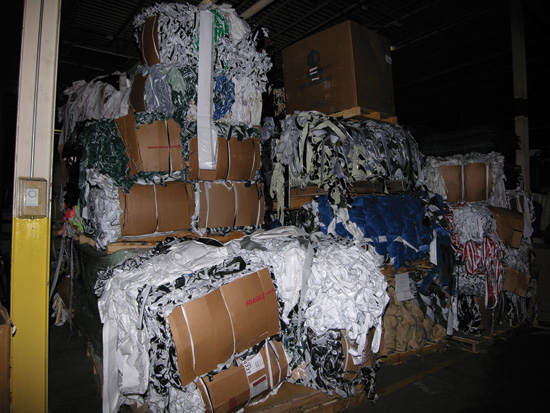
Photo courtesy of Duro-Last
Recycling and reclamation programs earn points in the standard.
Recycling and Reclaiming Roofing Membranes
For single-ply roofing membrane materials, unlike some other roofing products, there is potential for recyclability. The standard awards points for recycling post-consumer membranes into durable products with a documented 5-year or 10-year life expectancy. When a program for reclamation is in place—including chain of custody, tracking and a take-back process—points are awarded for achieving increasing annual performance targets. This encourages the membrane manufacturer to make a start on this process, with tens of thousands of pounds per year of reclaimed roofing membrane the first 2 years, twice that for the next 3 years, and four times that for years 6 and beyond.
In the Factory: The Roofing Membrane Manufacturing Process
Once the design, sourcing and recyclability factors are assessed, it's time to turn our attention to the actual manufacturing of the roofing membrane materials. Ideally, the items included here cause manufacturers to ask themselves: How do our manufacturing processes impact the environment, and how can we further improve on that?
As usual, improvements in procedures begin with policies and a formal Environmental Management System (EMS). To earn the maximum of 6 points, the membrane manufacturer should create a system that is specific to the manufacturing site, and have that audited annually. In addition, the EMS should be registered with a qualified third party. The intention is transparency and accountability.
In the development of NSF/ANSI 347, the stakeholders wanted to ensure that the environmental planning that was set into place during the design process would be carried through into manufacturing. Anyone familiar with the design and construction of buildings, and the disconnects that can happen between the designer and builders, will appreciate the importance of this effort. An extra point is available for a tracking system.
Conserving Energy and Considering Energy Sources
What would an environmental assessment be without attention to energy conservation? And of course, it is not only the direct energy metrics we worry about, but equally importantly the resultant greenhouse gas emissions from the production of the energy used. Save the energy, reduce the emissions. In the standard, membrane manufacturers earn points for both reduced energy consumption and for transitioning from energy from non-renewable sources to renewables such as wind, solar, biogas, and geothermal.
Also, the team that developed the standard had an awareness of the extra energy needed for operation of new pollution control equipment, recycling equipment and/or the increased energy needed for certain processes implemented for environmental benefits. Therefore, those increased usages will not be included in the calculations for the initial 5 years those processes are put in place.
Water and Waste Worries
Drought is still a significant issue in many parts of the Southwest United States, and along with growing awareness of the effects of global warming in general, has contributed to the inclusion of water conservation considerations in the single-ply roofing membrane standard. Manufacturers can earn points by an inventory of water used, and how it's used, along with reducing that consumption, and for using internal cooling loop processes to reduce water discharges. When the wastewater reaches drinking water quality standards, more points are awarded.
Further along the membrane manufacturing process, minimizing waste is important. Membrane manufacturers can reduce what goes to the landfill, minimize packaging materials, and document a recycling or reclamation program for used pallets.
Greenhouse Gas Emissions
Ideally, in the production of roofing membrane, there would be no release of greenhouse gasses (GHG). The manufacturer is encouraged to complete a baseline inventory of GHG emissions in accordance with ISO 14064, EPA standards, protocols established by the World Resources Institute (WRI) and World Business Council on Sustainable Development (WBCSD) or an equivalent standard.2
Looking past the initial assessment, the developers of this standard provided incentive for continued progress with increasing points for reductions of 2 percent, 4 percent and 6 percent.
Finally, a roofing membrane manufacturer is rewarded for participating in a GHG reporting program, where they annually inventory and report their emissions. Again, transparency of environmental impacts is stressed and incentivized.
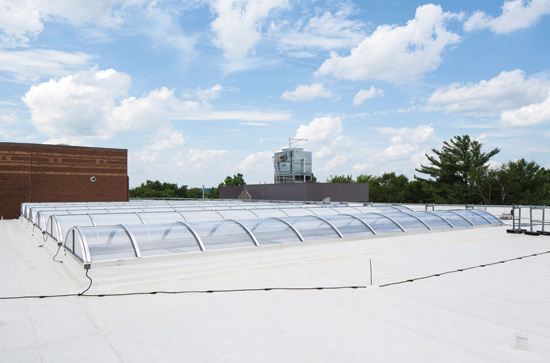
Photo courtesy of Duro-Last
The service life of a product or material could be the most important factor in sustainability.
Membrane Durability: How Long Will It Last?
While one could argue which of the criteria in this multi-attribute assessment is most critical, this one could well trump them all. After all the planning, raw material sourcing, manufacturing, packing and procedures are accounted for, if the product does not have a robust service life, the claim to sustainability will be in doubt.
Indeed, the NSF/ANSI 347 standard awards a whopping 12 points maximum for membrane durability. But first, two prerequisites must be met: Is there a documented installer-training program? And is a post-inspection protocol in place and actively practiced? When a product has an NSF/ANSI 347 certification, no matter what the level, an architect or specifier can be assured that these two quality-control measures are in place. As anyone familiar with the design and building industries can attest, poor installation can defeat a product's performance, no matter the product's initial quality. It's useful to note that the companies earning this certification have proven these critical elements are in place.
For true sustainability, service life in the field is key, and the standard offers from 1 to 10 points for demonstrations, attested to by a competent third party, that the product functions in the field from 10 to 30 years.
The materials a roofing membrane is made out of can contribute to its durability. For example, PVC is known to be an extremely serviceable and durable material. PVC roofing membranes are flame resistant, highly flexible, extremely recyclable and deter bacterial growth—giving them a longer life on the rooftop.
Further points are available for reflectivity according to Energy Star or equivalent reflectivity criteria, as well as for a maintenance and quality management system, and field performance evaluation processes.
The Overall Picture—Corporate Accountability to Social Issues
For a membrane manufacturer to achieve an NSF/ANSI rating, the areas of concern reach far beyond the actual membrane. They also address wide-reaching issues of how the corporation is operated.
For any company or builder or designer whose own social responsibility standards include bans on these practices, specifying a NSF/ANSI 347-certified roofing membrane is one way to ensure compliance with key corporate values.
In addition, prerequisites include compliance —at all manufacturing plants where the membrane is being evaluated—with all applicable laws and regulations concerning collective bargaining, wage standards, working conditions and non-discrimination in employment.
A robust safety improvement program is also built into this standard, and companies are rewarded with points for a published safety improvement manual, annual reporting of accident and injury rates, and an annual summary of safety improvement activities.
Commitment to Community Investment
In another prerequisite that reaches far beyond the membrane material itself, this standard requires all companies deemed compliant or better to invest in communities in the form of grants and contributions within the communities where its products are manufactured and used.
These community activities, according to the standard might include:
• Donations of roofing materials or reimbursement of roof installation labor costs for community projects throughout the country where they are manufactured.
• Donations to service or other charitable organizations located within a 30-mile radius of any primary manufacturing or distribution facility.
• Donations to non-profit organizations associated with the roofing industry.
• Donations to roofing industry scholarship funds or direct scholarships for students in construction-related educational programs.
Innovation Rewarded
To encourage continued innovation that leads to increased environmental benefits, manufacturers of single-ply roofing membrane can earn up to 7 points in the standard for such activities. Additional points are available for exceeding the aggressive targets in the standard, in some categories such as increasing environmentally sustainable content, reduction of energy consumption, investment of capital in renewable energy at the manufacturing plant, reduced water consumption and minimization of waste materials.
Architects and Specifiers Use NSF/ANSI 347 to Achieve Sustainability Goals
Market demand for products that comply with green building standards has increased exponentially during the past decade. The U.S. Green Building Council estimates that more than 3.6 billion sq. ft. of office space are certified by the LEED rating program. According to a Dodge Data & Analytics World Green Building Trends 2016 SmartMarket Report, the global green building sector continues to double every three years. Global respondents indicate that 60 percent of their projects will be green by 2018.3
The 2018 USGBC annual list of top 10 states for green building per capita, which ranks states in terms of certified square feet per resident, includes Massachusetts as number one, followed by New York, Illinois, Hawaii, and Maryland.4
The U.S. Green Building Council's LEED Rating System
While LEED doesn't have a designated credit for multi-attribute sustainability standards, the due diligence to earn the NSF/ANSI 347 credits can help manufacturers get a head start on the required documentation for USGBC's latest LEED revision, version 4 (v4)—updated with addenda in July 2018.
As with the previous version of LEED, there are credit challenges that building product manufacturers must navigate through. When LEED was first introduced, manufacturers had to play catch up, but now reporting recycled materials or VOC content is second nature. The credits in NSF/ANSI 347 can help give the manufacturer a leg up on the LEED v4 Material and Resources credits that require material chemistry disclosures and EPDs.
The Certified Multi-attribute Products and Materials credit began as a pilot credit in 2013. The pilot credit requires use of products from manufacturers who have validated multiple environmental attributes relevant to the product via independent, consensus-based, third-party certifications. In addition, the products must meet the life-cycle assessment credits within the certification.5
The chemicals of concern section of NSF/ANSI 347 help address the growing demand of material chemistry transparency, which is addressed in the Building Product Disclosure and Optimization – Material Ingredients credit. To fulfill the Chemicals of Concern NSF/ANSI 347 credits, the manufacturer creates an ingredient inventory of the product to 0.1 percent (1000 ppm). This inventory can then be entered into an HPD that analyzes the chemical hazards against 23 ”red lists” and complies with the LEED v4 credit.
HPDs, however, have been scrutinized by manufacturers and the chemical industry for only acknowledging chemical hazards and not focusing enough on risk. If a product contains a chemical with a hazard but does not pose any risk of exposure, do the manufacturers need to disclose that chemical? There have also been concerns over proprietary ingredients which can be a huge roadblock to the manufacturer if its supplier won't disclose full formulations. More recent versions of the HPD Open Standard have addressed these concerns. Information about exposure or risk specific to the product, as well as other issues that may be relevant to help further interpret information, is now documented in the notes and/or certifications sections of an HPD. Proprietary ingredients, whose chemical identity is not provided, cannot be labeled as identified and must be labeled as unknown, with an explanation. The latest version, HPD Open Standard V2.1.1, was released on July 2, 2018.
ANSI/ASHRAE/IES/USBGC Standard 189.1-2014, Standard for the Design of High-Performance Green Buildings
With all the green building and energy codes and standards, it can be confusing to figure out which codes apply to a project's location and how they impact green building rating systems. To help solve this issue ANSI, ASHRAE, the Illuminating Engineering Society of North America (IES) and USGBC announced a memorandum to collaborate on the development of Standard 189.1, IgCC, and LEED. The goal of this unprecedented agreement is to “create a comprehensive framework for jurisdictions looking to implement and adopt green building regulations and codes and/or provide incentives for voluntary leadership programs such as LEED.”7 Standard 189.1 already recognizes the importance of multi-attribute sustainability assessments by integrating NSF/ANSI 347 certification in its Atmosphere, Materials and Resources section.
International Green Construction Code (IgCC)
The IgCC was the first model code to include sustainability measures for the entire construction project and its site—from design through construction, certificate of occupancy, and beyond. The 2015 version of the code was developed to make buildings more efficient, reduce waste, and have a positive impact on health, safety, and community welfare, and NSF/ANSI 347 is included as a sustainability standard in the IgCC.
While adoption of the 2015 IgCC faced challenges due to confusion within the building community over the various standards mentioned above, the 2018 IgCC, when released, will be a good example of cooperation between the various standards organizations, including ANSI, ASHRAE, IES, and USGBC Standard 189.1.
Conclusion
While the standard, code or rating system for sustainable building materials may evolve over time, the drive toward sustainable practices will likely continue on a strong trajectory with increasing market share. To prevent the watering down of both the science of sustainability and the perception of true and verifiable sustainability claims, more and more products will have strong third-party certifications.
Single-ply roofing membranes are now ahead of the green curve thanks to the NSF/ANSI 347 sustainability assessment. By paying attention to which roofing membranes that have earned a compliant, silver, gold or platinum rating, architects and specifiers can be one step closer to achieving their sustainability goals.
Endnotes
- http://www.nsf.org/services/by-industry/sustainability-environment/sustainability-standards-protocols/single-ply-roofing-membranes/
- http://www.ghgprotocol.org
- http://www.usgbc.org/articles/green-building-facts
- https://gresb.com/usgbc-annual-top-10-states-for-leed-green-building-per-capita/
- https://www.usgbc.org/credits/new-construction-core-and-shell-schools-new-construction-retail-new-construction-healthc-112
- http://www.iccsafe.org/codes-tech-support/international-green-construction-code-igcc/international-green-construction-code/
- http://www.usgbc.org/articles/leading-building-industry-groups-agree-streamline-green-building-tool-coordination-and-deve
|
|
| Known as the "World's Best Roof®," a Duro-Last® roof is perfect for any flat, low-sloped, new or retrofit application. Precision-fabricated accessories combined with prefabricated deck sheets or roll goods allow for a watertight roof that doesn’t sacrifice aesthetics. www.duro-last.com |





